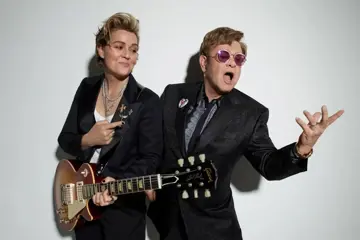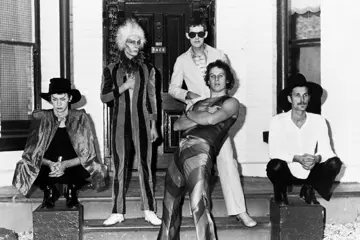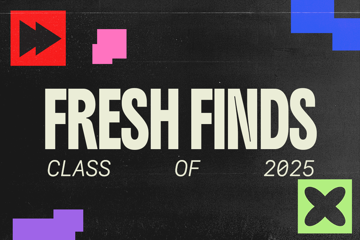Hot on the heels of data from US research company Luminate that Australian artists only rank 9.2 per cent with music streaming fans comes another report with more disturbing figures.
Down And Under Pressure: The Decline of Local and Non-Anglo Best-Selling Recording Artists In Australia 2000–2023 is a study of the Top 100 charts in the past 23 years.
It showed that in 2023, Aussie and New Zealand (ANZ) artists made up just 2.5 per cent of singles. It’s been a steady decline, from an average of 16 per cent in 2000–2016, to around 10 per cent in 2017–2023.
The quality of local albums remains astounding and gains critical acclaim around the world. But they just had a 4.15 per cent share in 2023. That figure was an average of 29 per cent in 2000–2016, and 18 per cent in 2017–2023.
Australian Recording Industry Association (ARIA) CEO Annabelle Herd has long acknowledged the problem: “There are simply not enough Australian artists – let alone new Australian artists – breaking through with their home audience.”
Don't miss a beat with our FREE daily newsletter
Down And Under Pressure was recently published in the International Journal of Music Business Research. It was researched by Tim Kelly, a former music executive and PhD candidate at the University of Technology Sydney (UTS).
“I was expecting a drop but not such a significant drop,” Kelly admits. “It blew me away that when streaming came, its impact was so striking.”
The arrival of music streaming promised greater diversity of sounds, and where Australian music operated on an even playing field. More indie music would be spotlighted. Australian artists from First Nations and multicultural backgrounds would break through, as would music from non-English-speaking countries.
“However, that has not been the case in Australia, at least as far as chart-topping artists are concerned,” he notes. “Instead, global consolidation of the music industry has led to homogenised consumption, where music from the US and the UK are dominating.”
In 2023, albums from the US which charted locally made up an astounding 65.5 per cent. Those from the UK were 17.85 per cent. Canada was 8.5 per cent, and Australia marked fourth with 4.15 per cent. Those from the Barbados were 2 per cent, and those from Sweden and Trinidad were both 1 per cent.
On the singles charts, Americans marked 59.51 per cent, and the Brits were 24 per cent. Canadians were 7.83 per cent, and Aussies were 2.5 per cent. After that were the French at 1.5 per cent, while Germans and Irish made up 1 per cent each.
According to Down And Under Pressure, the peak year of diversity by nationality on the ARIA singles chart was 2000. There were hits from 14 countries. In 2023, the number slipped to seven countries.
ANZ chart representation averaged 19.6 per cent between 2000 and 2009, with a peak of 25 per cent in 2004. It dropped to 10.5 per cent between 2017 and 2023, and continuing on its downward trajectory in 2013.
First Nations
The chart presence of First Nations acts has not grown despite greater profile, especially of the likes of The Kid LAROI and Jessica Mauboy. FN representation was 4 per cent, with Government data indicating that First Nations people make up 3.8 per cent of the Australian population.
Says the report, “Indigenous Australian artists appear to have low representation in the charts both overall and in relation to non-Indigenous Australians. However, whilst from a low base, the number of charting Indigenous artists has not changed significantly over the period.
“During the 24-year period in review, 14.5 singles by 4 artists held placings in the end-of-year single charts. These 14.5 singles represent just 0.6 per cent of the 2,400 charting singles during the period.
“However, in the context of Australian-only artists, the data shows that of the 333.5 Australian artist singles that made the annual charts during the period, as a percentage, Australian Indigenous artist share is 4.3%.
“In the album charts, 23.75 albums by eight artists held placings in the end-of-year charts. These 23.75 albums represent 0.99 per cent of the 2,400 charting albums over the period. However, in the context of Australian-only artists, the data shows that of the total of 599.2 Australian artist albums that made the annual charts during the period, as a percentage, Australian Indigenous artist share is 4 per cent.”
The report adds: “It is interesting to note that whilst the nine Indigenous charting artists are split five males to four females on gender lines, it is the female artists that account for 60.8% of all Indigenous chart entries. This is mainly due to the success of Jessica Mauboy, who accounts for an extraordinary 42.5 per cent of all Indigenous chart entries.”
Rest Of The World
When it comes to Rest of the World, Europe has been the most consistent provider of artists for Australian charts. It peaked in 2016 with a 15.3 per cent share but now down to 4.7 per cent.
The Caribbean was 6.75 per cent in 2006, 6.6 per cent in 2011 and 7.7 per cent in 2012 but has fallen to 0.8 each year since 2017.
Non Anglo-Saxon territories cover Asia, Africa, South America, Eastern Europe and the Middle East.
These peaked in 2002 with three chart entries and average 1.9 per cent since 2017. Combined non-Anglo regions averaged 11.1 per cent chart share between 2000 and 2016, declining to 7.3 per cent since 2017, with 2023 recording a 5.2 per cent share.
The report notes: “Combined, the Anglo regions of North America (US & Canada) UKE (UK & Eire) and ANZ increased chart share from 91 per cent in 2000, an average of 95 per cent in 2000–2016, to an average of 97.7 per cent in 2017–2023.
“As with the single chart data, the increase in Anglo chart share did not benefit ANZ artists as the NA portion of the Anglo share increased by an average of 12.2% from 2017, whilst ANZ share declined by 10.9% during the same period.”
Number of Factors
Tim Kelly blames a number of factors at play for the low chart success of Aussie acts. But they were worsened by streaming and algorithmic direction.
The high level of market concentration of the global recorded music industry, is partial to American musicians when it comes to those being signed, financed and marketed.
“With big companies which operate under US governance, that tends to favour the home market,” Kelly explains.
“That approach is utilitarian because of the greatest number of people. Australia hasn’t got a significant population, so the thumbprint of Australian artists is very small. Australian music doesn’t tend to travel out while US music does.”
The Australian recorded music market, worth $676 million in 2023 and up 10.9 per cent year on year, is hard done by global market concentration.
Kelly’s analysis shows that the three major labels (Universal Music Group, Sony Music Entertainment, Warner Music Group) control over 90 per cent of the annual top 100 chart share, and three distributors (Spotify, Apple, YouTube) account for over 85 per cent of all recorded music sales.
It’s a different story in Europe. In places like Germany and France which have distinctive languages, “there have been more (local) artists in the charts since streaming.”
The other issue is that with the business moving to a catalogue economy which is low cost and prone to smaller royalty rates – two thirds of Australian music sales are older records – it is harder for new Aussie artists to break through.
Last year, only 21 Aussie tracks were in the Top 100 played on Aussie radio and all were established names. The highest ranking was Peking Duk’s I Want You ft. Darren Hayes at Number 13 with 18,693 spins, followed by The Kid LAROI’s Love Again at Number 29 and Troye Sivan’s Rush at Number 38.
According to label executive claims in The Black Hoody, high rotation tracks on triple j now get only 60-80 spins compared to 120-140 spins ten years ago.
Flux Of Pink
Hailing from the UK, Kelly, one-time guitarist of Flux Of Pink Indians guitarist, helped set up the very cool One Little Indian Records, which signed Björk, The Shamen, Sneaker Pimps, Alabama 3 and Skunk Anasie, among others.
After a stint at Rough Trade as Head of International, he moved to Australia, where from 2005, he was GM of Marketing for almost two decades at Sony Music and Universal Music, working with Australian acts.
In 2014 he became Managing Director of Inertia Music, and two and a half years later, Head Of Department at creative education provider JMC Academy. For the past three years, he’s been Program Director of the Australian Institute of Music.
Kelly was also a member of the ARIA Chart and Marketing Committee from 2005 to 2014 and 2015 to 2017. He had a firsthand view as the number of major labels in Australia shrunk to just three.
“When I started this research, there’d been talk about the lack of Australians in the charts. At the back of my mind, I was more interested in how the global consolidation of the recorded music industry impacted decision-making for artists and artist managers.
“So what I did was some quantitative analysis to see if there were any demographic shifts in the charts.”
Negative Flow-On
The prominence of majors and distributors in this market “gives them a disproportionate influence over music production, distribution design, and licensing deals, stifling competition and limiting opportunities for diversity and independent artists.”
A low presence of Australians in the charts has a negative flow-on effect. There are less diverse cultural expressions for local consumers to relate to.
The country is lessened in the eyes of the world as a place of diverse music or wrongfully regarded as a nation of whitebread tastes that has not fully appreciated global success stories such as K-Pop, Latin, Afrobeat, J-Pop, Cantopop and Bollywood. These non-English language tracks declined by about 30% over singles and albums.
“When local artists succeed, it attracts global investment, which in turn stimulates and benefits the Australian music industry and consumers,” Kelly points out. (Australian majors themselves do not reveal the extent of their investment in their domestic roster).
Economically, the situation restricts the range of jobs available. According to the Australian Institute of Music, over 300,000 are employed across music and performing arts, venues and live music, and independent songwriters, artists, composers, DJs and musicians.
There are 560 different job titles, and the average salary of $108,000 has the potential to increase by 9 per cent by 2028.
The music industry has suggested that ways to increase the local chart presence lies with the Government. This is by tax incentives, similar to those given to the screen industry, to promote investment from private and corporate sources.
Another is the setting up of a well-resourced government agency that can connect local content with local audiences. It will be similar to New Zealand’s NZ On Air which funds the creation and promotion of local content across screen and music and works to increase streaming of local music in New Zealand and the percentage of local music on commercial radio.
With 120,000 tracks uploaded internationally on Spotify each day, a favourite rate offered to streaming platforms to playlist new Australian music is something to consider.
















